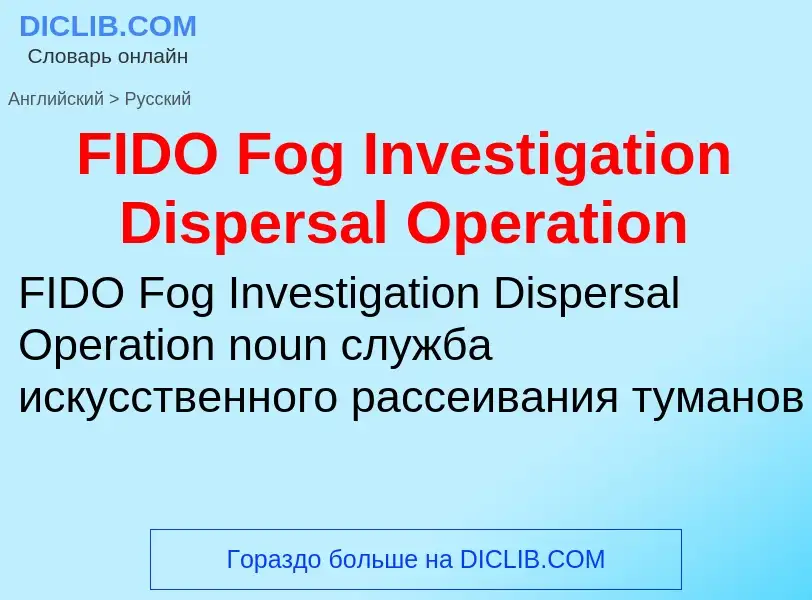Tradução e análise de palavras por inteligência artificial ChatGPT
Nesta página você pode obter uma análise detalhada de uma palavra ou frase, produzida usando a melhor tecnologia de inteligência artificial até o momento:
- como a palavra é usada
- frequência de uso
- é usado com mais frequência na fala oral ou escrita
- opções de tradução de palavras
- exemplos de uso (várias frases com tradução)
- etimologia
FIDO Fog Investigation Dispersal Operation - tradução para Inglês
общая лексика
путь расселения
Definição
Wikipédia

Fog Investigation and Dispersal Operation (FIDO) (which was sometimes referred to as "Fog Intense Dispersal Operation" or "Fog, Intense Dispersal Of") was a system used for dispersing fog and pea soup fog (dense smog) from an airfield so that aircraft could land safely. The device was developed by Arthur Hartley for British RAF bomber stations, allowing the landing of aircraft returning from raids over Germany in poor visibility by burning fuel in rows on either side of the runway.
The FIDO system was developed at the department of chemical engineering of the University of Birmingham, United Kingdom, during the Second World War. The invention of FIDO is formally attributed to Dr John David Main-Smith, an ex-Birmingham resident and principal scientific officer of the Chemistry Department of the Royal Aircraft Establishment at Farnborough, Hampshire, and as a courtesy the joint-patent (595,907) held by the Ministry of Supply was shared by the department head Dr Ramsbottom as was normal practice at the time. This formal government recognition is enshrined in an Air Ministry postwar letter to the late inventor's late widow and held by his son, Bruce Main-Smith (February 2008). It also deals with the lesser role of those developing support equipment, notably the FIDO burner.
"It is my memory", writes Bruce Main-Smith, "that much of the airfield installation was pioneered at Hartford Bridge Flats airfield (aka Blackbushe near Yateley, Surrey [sic]) a convenient few miles from the RAE's Farnborough aerodrome." Though J. D. Main-Smith co-owned the FIDO patent, no royalties accrued from any UK civilian usage after World War II, its being too petrol-hungry. At an attempt to quantify the saving of aircrew life, Bruce Main-Smith suggests possibly 11,000 airmen but not all would be fit to fly again.
It is difficult for the modern (2008) UK resident to comprehend what World War II fogs were like. It was not uncommon for a person to be unable to see the hand at the end of an outstretched arm. The post-war Clean Air Act hugely ameliorated UK fogs.


![''FIDO in Operation'', 1945 (Art.IWM ART LD 5593), [[Alan Sorrell]], Imperial War Museum ''FIDO in Operation'', 1945 (Art.IWM ART LD 5593), [[Alan Sorrell]], Imperial War Museum](https://commons.wikimedia.org/wiki/Special:FilePath/FIDO in Operation (Art. IWM ART LD 5593).jpg?width=200)

 petrol pipes on either side of the main runway, 28 May 1945. CH15275.jpg?width=200)

![[[Bur]]s are an example of a seed dispersion mechanism which uses a biotic vector, in this case [[animal]]s with [[fur]]. [[Bur]]s are an example of a seed dispersion mechanism which uses a biotic vector, in this case [[animal]]s with [[fur]].](https://commons.wikimedia.org/wiki/Special:FilePath/Bur Macro BlackBg.jpg?width=200)



![Aura River]] in [[Turku, Finland]] Aura River]] in [[Turku, Finland]]](https://commons.wikimedia.org/wiki/Special:FilePath/Aurajoki morning fog.jpg?width=200)
![motion trails]] are captured as streaks. motion trails]] are captured as streaks.](https://commons.wikimedia.org/wiki/Special:FilePath/FogParticles.jpg?width=200)
![orbs]]. orbs]].](https://commons.wikimedia.org/wiki/Special:FilePath/FogParticlesHighSpeed.jpg?width=200)
![[[Sutro Tower]] casts a 3-dimensional fog shadow [[Sutro Tower]] casts a 3-dimensional fog shadow](https://commons.wikimedia.org/wiki/Special:FilePath/Fog shadow tv tower.jpg?width=200)
![A massive fog bank over [[Twentynine Palms, California]], covers the entire city as it begins to rise and join the [[cloud]]s above it. A massive fog bank over [[Twentynine Palms, California]], covers the entire city as it begins to rise and join the [[cloud]]s above it.](https://commons.wikimedia.org/wiki/Special:FilePath/Rising desert fog bank.jpg?width=200)
![Advection fog layer in San Francisco]] with the [[Golden Gate Bridge]] and skyline in the background Advection fog layer in San Francisco]] with the [[Golden Gate Bridge]] and skyline in the background](https://commons.wikimedia.org/wiki/Special:FilePath/San francisco in fog with rays.jpg?width=200)


![Pogonip fog in [[Virginia City, Nevada]], from an early 20th-century postcard Pogonip fog in [[Virginia City, Nevada]], from an early 20th-century postcard](https://commons.wikimedia.org/wiki/Special:FilePath/PostcardVirginiaCityNVPogonipCirca1907.jpg?width=200)

![Pyhäjärvi]], [[Tampere]] during sunset. Pyhäjärvi]], [[Tampere]] during sunset.](https://commons.wikimedia.org/wiki/Special:FilePath/Näsijärvi, Tampere, Finland. January 2019.jpg?width=200)
![Fog rolls into [[Seattle]] from the sea Fog rolls into [[Seattle]] from the sea](https://commons.wikimedia.org/wiki/Special:FilePath/Seattle Columbia Pano2.jpg?width=200)
![Sea fog or "fret" encroaching on [[Brighton Pier]] Sea fog or "fret" encroaching on [[Brighton Pier]]](https://commons.wikimedia.org/wiki/Special:FilePath/Sea fog encroaching on Brighton pier.jpg?width=200)
![Sea fog in the [[Arctic Ocean]] near the island of [[Jan Mayen]] Sea fog in the [[Arctic Ocean]] near the island of [[Jan Mayen]]](https://commons.wikimedia.org/wiki/Special:FilePath/MS Europa vor der Insel Jan Mayen im Nebel - 2011.png?width=200)
![Maple tree with red leaves in the morning mist, in western [[Estonia]] Maple tree with red leaves in the morning mist, in western [[Estonia]]](https://commons.wikimedia.org/wiki/Special:FilePath/Udusse mattuv harilik vaher, punaste sügislehtedega. Läänemaa.jpg?width=200)
![A fog on the field of the Leppälahti ja Kuivaniemi villages in [[Kuopio]], Finland A fog on the field of the Leppälahti ja Kuivaniemi villages in [[Kuopio]], Finland](https://commons.wikimedia.org/wiki/Special:FilePath/Kuivaniemen peltoja.jpg?width=200)

![Fog surrounding skyscrapers in the [[Melbourne city centre]] Fog surrounding skyscrapers in the [[Melbourne city centre]]](https://commons.wikimedia.org/wiki/Special:FilePath/Amazing Fog in Melbourne.jpg?width=200)
![Light fog over [[Taipei]], [[Taiwan]] with [[Taipei 101]] in the background Light fog over [[Taipei]], [[Taiwan]] with [[Taipei 101]] in the background](https://commons.wikimedia.org/wiki/Special:FilePath/Foggy Taipei skyline 20190321.jpg?width=200)
![Fog in [[London]] with the [[Palace of Westminster]] in the background Fog in [[London]] with the [[Palace of Westminster]] in the background](https://commons.wikimedia.org/wiki/Special:FilePath/Westminster fog - London - UK.jpg?width=200)
![Aqua]] satellite in December 2012 Aqua]] satellite in December 2012](https://commons.wikimedia.org/wiki/Special:FilePath/Dense fog over Indian Subcontinent.jpg?width=200)
![Fog partially obscuring a mountain in [[Tirupati]] in the [[India]] summer. Fog partially obscuring a mountain in [[Tirupati]] in the [[India]] summer.](https://commons.wikimedia.org/wiki/Special:FilePath/Fog over mountain.jpg?width=200)
![High Desert]] community in the western US, while leaving the mountain exposed. High Desert]] community in the western US, while leaving the mountain exposed.](https://commons.wikimedia.org/wiki/Special:FilePath/High Desert Fog.jpg?width=200)
